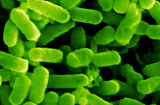Preventing E. coli Infections
Written Dec. 2006; updated Jan. 2008.
E. coli infections can happen any time. Learn about precautions that can protect you and your family.
What Is E. coli O157:H7?
E. coli bacteria are normally found in the intestines of humans and animals. Although most strains are harmless, a few, such as E. coli O157:H7, can cause severe diarrhea and potentially deadly complications. E. coli O157:H7 can survive at extreme temperatures. Only a few bacteria cells are needed to cause illness.
Symptoms of E. coli Infection
The most common symptoms of E. coli O157:H7 infection are diarrhea and bloody stool. If you experience one or both of these symptoms, seek medical attention as soon as possible. Most people experience full recovery within one week, but some people--particularly children and the elderly--can develop a type of kidney failure called Hemolytic Uremic Syndrome (HUS).
Preventing the Spread of E. coli
The best way to prevent E. coli bacteria from spreading is to wash your hands thoroughly with hot, soapy water, especially while cooking and after using the bathroom.
Cooking food at 160° Fahrenheit for fifteen seconds can kill E. coli O157:H7. However, certain methods of cooking--such as using a frying pan--may not be completely effective. All the bacteria may not be killed if all parts of the food do not reach 160°F.
There is also a risk of cross-contamination when food touches kitchen surfaces or other food products. Be sure to wash your hands, utensils, and food preparation surfaces with hot, soapy water before and after handling food, especially meat products.
Adapted and excerpted from:
H. Petridis, et al, E. coli O157:H7: A Potential Health Concern (SL-146), Soil and Water Science Department (rev. 10/2002).
K. Schneider, Preventing Foodborne Illness: E. coli O157:H7 (FSHN031), Food Science and Human Nutrition Department (rev. 11/2009).

Related Sites & Articles
- Hot Topics
- Food Safety
- Grill Safety
- Hand Washing
- Salmonella Infections
- Turkey Food Safety
- UF/IFAS Publications
- E. coli
- Other Sites & Publications
- E. coli--KidsHealth
- Escherichia coli O157:H7--CDC
- Fight BAC!--Partnership for Food Safety Education
- Foodborne E. coli--National Institute Health

